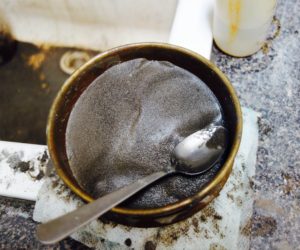The main parts of a mud logger’s job include dealing with the samples (catching, cleaning, analyzing, recording), monitoring, and recording the gas, recording the drilling information from the rig, and generating reports.
When a hole is drilled through anything whether it is your living room wall or the ground the process is the same. The drill bit grinds up the material and moves it out of the way so the hole can be bigger and deeper. When the bit is hundreds of feet below the surface it takes time and a little help to get the cuttings out of the way. That’s where the mud comes in. The mud acts like a big conveyer belt and whisks the cuttings back to ground level. Where yours truly is waiting for them. After washing and shaking they look like this.

I know it doesn’t look like much but to us it tells a story. I add this piece to the other pieces and the whole story starts to take shape. The other pieces are things like the gas. When the rock is drilled sometimes there is gas that is released this is also carried to the surface by the mud. It is then separated from the mud and piped directly into my shack were really expensive equipment breaks it down into its chemical components. That goes on the log too.
Other things go on the log like speed, depth, and pressure. When you add it all together we get a pretty clear picture of what the rocks look like. Are the rocks hard or soft. Do they have lots of minerals or any fossils. Is there lots of space between the grains or is it a well packed formation. And most importantly is there any oil in the rocks and how hard is it to get out. And all of that goes on into the daily report.
